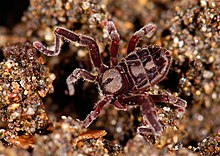| Ricinulei Temporal range:
| |
|---|---|

| |
| Cryptocellus goodnighti | |
| Scientific classification | |
| Domain: | Eukaryota |
| Kingdom: | Animalia |
| Phylum: | Arthropoda |
| Subphylum: | Chelicerata |
| Class: | Arachnida |
| Order: | Ricinulei Thorell, 1876 |
| Family: | Ricinoididae Ewing, 1929 |
| Exant genera | |
|
For fossil genera, see text | |
Ricinulei is a small order of arachnids. Like most arachnids, they are predatory; eating small arthropods. They occur today in west-central Africa (Ricinoides) and the Americas (Cryptocellus and Pseudocellus) from South America to as far north as Texas, where they either inhabit leaf-litter or caves. As of 2022, 103 extant species of ricinuleids have been described worldwide, all in the single family Ricinoididae.[1] In older works they are sometimes referred to as Podogona. Due to their obscurity they do not have a proper common-name, though in academic literature they are occasionally referred to as hooded tickspiders.
In addition to the three living genera, Ricinulei has a fossil-record spanning over 300 million years, including fossils from the Late Carboniferous of Euramerica and the Cretaceous Burmese amber.
- ^ Valdez-Mondragón, Alejandro; Juárez-Sánchez, Alma R. (2021-02-23). "A new epigean species of ricinuleid of the genus Pseudocellus (Arachnida: Ricinulei: Ricinoididae) from a tropical sub-deciduous forest in Oaxaca, Mexico". The Journal of Arachnology. 48 (3). doi:10.1636/JoA-S-20-014. ISSN 0161-8202. S2CID 232021020.